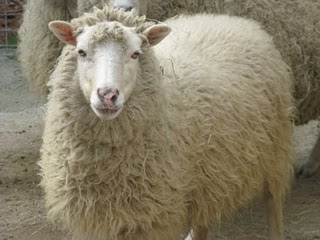 Wilco is one of five sheep living in our farmyard. She is the easiest sheep to identify because she is the smallest and has a black spot on her nose. Of our five sheep, there are two mothers, two daughters (one to each mother) and a male (whom is not related to, nor the father of, the other sheep). Wilco is one of our mothers. Surprisingly enough, both of the mother sheep are significantly smaller than their daughters!
Wilco is one of five sheep living in our farmyard. She is the easiest sheep to identify because she is the smallest and has a black spot on her nose. Of our five sheep, there are two mothers, two daughters (one to each mother) and a male (whom is not related to, nor the father of, the other sheep). Wilco is one of our mothers. Surprisingly enough, both of the mother sheep are significantly smaller than their daughters!
Wilco was born in December of 2000 at a farm in North Carolina, so she is just over 8 years old. From there, she came to the museum in June of 2002 with her newborn baby, Mutton. Wilco is the sheep that is most likely to approach the fence if you are standing there. Even though our sheep have been around people all their lives, they are still quite skiddish of visitors as well as the keepers. They like to stay together, which is an instinctive “flock” behavior for sheep. Being prey animals, they are less vulnerable to predators if they stay in a close circle and move as a unit. By staying in a flock, the animals in the middle of the circle are safe, and it is much more difficult for a predator to single out a specific animal to kill. For this reason, sheep can become stressed out if they are separated from their flock. Occassionally we witness this with our sheep when we have to catch one of them so that they can be examined by a veterinarian.
Another characteristic that helps sheep stay safe from predators is their amazing peripheral vision. Sheep have pupils that are slit-shaped and allow them to see anywhere from 270 degrees to 320 degrees around them! This means that sheep can see things behind them without even turning their heads. However, they do not have good depth perception, so fluctuations and dips in the ground can prove more difficult for them than for most animals.
Being native to the Gulf Coast of Florida means that these sheep are well adapted to warm weather. When the hot days of June come, many visitors worry that the thick coat of wool they have will cause them to overheat. On the contrary, the wool has the opposite effect. In actuality, the wool helps to repel the rays of the sun and keep cooler temperatures closer to their body. So while we are feeling the effects of the hot weather, the sheep are laying out in the sun and still cooler than we are! For this reason, the benefits of getting our sheep sheared once a year has more to do with health and cleanliness than it does weather. And even though we don’t use their wool for clothing, it still serves a good purpose by becoming enrichment for our other animals.
You can watch a video of our sheep being sheared from last year, as well as read a previous post about how much our sheep enjoy receiving Russian-olive (an invasive leafy shrub) as a treat and enrichment item.
The information in this post can be found at http://en.wikipedia.org/wiki/Sheep